Cereal Killers
Cereal Killers covers the pests, diseases, and weeds that try to kill arable crops. Each week we do a deep dive on one challenge facing arable farmers. Hopefully revealing some new insights to help you fight these pernicious beasts, bugs and pathogens! If you are a farmer or agronomist, we would love to interview you on the podcast. Please email Russell@eutrema.co.uk Cereal Killers is hosted by: Dr Russell Sharp, Managing Director of Eutrema Ltd Josie Cuccia, Lecturer at Moulton College
Episodes
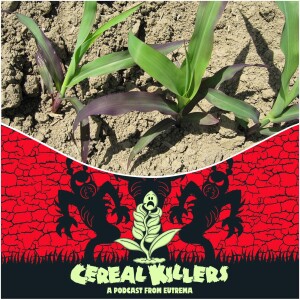
Friday Jun 28, 2024
Friday Jun 28, 2024
The main way of correcting phosphorus deficiency in soils is to add a phosphorus-containing fertiliser. However, your current situation will determine the actual form you should opt for. This post is solely focused on these phosphorus-containing fertilisers. We will be publishing additional blog posts about the symptoms and challenges of phosphorus deficiency, and also on how to release phosphorus already bound in the soil.
There are a number of different sources of phosphorus found in fertilisers. The chemists at fertiliser companies have chosen the specific ones used in a formulation based on 1. performance on the plant, 2. stability in the blend and 3. cost.
Here is a non-exhaustive list of common phosphorus-containing ingredients used in fertiliser:
Rock phosphates – ‘Beneficiated’ (cleaned up) rock phosphate is permitted for use as an organic fertiliser. This is before it is converted to conventional fertilisers by a series of chemical reactions. Whilst organic, beneficiated rock phosphate is not readily soluble, so is rarely used in conventional agriculture.
Superphosphate and Triple superphosphate- These are two forms of mono-calcium phosphate. They are both commonly found in granular arable fertilisers. They suit this role as unlike the phosphates listed below they do not dissolve straight away, instead only a gram or two will dissolve for every litre of water they are exposed to. Superphosphate is created by reacting rock phosphates with sulphuric acid, and triple-superphosphate is created by reacting rock phosphate with phosphoric acid.
Monoammonium phosphate (MAP) and diammonium phosphate (DAP) – both used in liquid NPK blends (compound fertiliser) and also sold as a straight granule product. They are created by reacting phosphoric acid (sourced from rock phosphate with ammonia from the Haber-Bosch process).
Potassium phosphate – mainly used in horticulture either on its own as a PK fertiliser, or blended into soluble fertilisers (both liquid and granular). Useful in situations where growers want healthy flowers, fruits and roots, but without stimulating excessive vegetative growth, and so preferable to MAP/DAP as that contains nitrogen. Can also be used to adjust the pH of foliar solutions and the effects on the crop. Alkaline forms will close plant stomata in periods of stress, whilst acidic potassium phosphate will open stomata and promote transpiration when this is desirable.
Potassium pyrophosphate – mostly horticultural but also in some arable foliar formulations. Similar use to mono potassium phosphate, but the phosphate releases over a period of days and thus controls its release and limits lock up.
Phosphoric acid – It might surprise you to find out that this hazardous acid is found in both conventional and organic fertilisers! In fact some arable foliar fertilisers based on phosphoric acid can have a pH of 1.0, and many organic fertilisers are also not far off this level too.
It is not just humans that need to be cautious when it comes to phosphoric acid fertilisers, as the plant can also be harmed by improper use. Any acidic fertiliser can strip calcium out of the leaf in the same way acidic rain drains a plant of essential nutrients.
Phosphoric acid is found in organic fertilisers because it is permitted for use to break down biological material in organic fertilisers. This is the reason you may see a fish fertiliser with very high phosphorus levels. It is not the biological material that is especially high in phosphorus, it is the acid used to extract and solubilise it.
Dicalcium phosphate and tricalcium phosphate: found in animal feed and in controlled-release fertiliser granules. However, these are not normally plant available. In controlled release fertiliser granules they are used as a binding agent (along with ferric phosphate. The only way to release dicalcium phosphate and ferric phosphate in the soil is to use Eutrema’s Phosphorus Liberator (more on this in the next post).
Controlled-release fertilisers are a relatively expensive product, so are usually only used in horticultural, not agricultural crops.
Guano – bird and bat droppings. Even though a natural source, not all guano is organic as it depends on the way it is mined. Often bat guano is organic, whilst that sourced from bird (albatrosses) is not. Dog poo is also a source of phosphorus, so much so that its deposition has been linked to the decline of wildflowers in nature reserves (https://www.newscientist.com/article/2307320-dog-waste-may-harm-nature-reserve-biodiversity-by-fertilising-the-soil/)
Understanding the diverse array of phosphorus fertilisers is pivotal for optimising soil health and crop productivity.
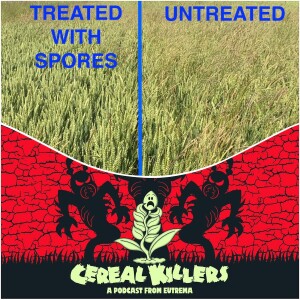
Monday Jul 15, 2024
Monday Jul 15, 2024
Black Grass Biology Group
2024 progress report
On-farm trials
This year we partnered with 16 farms to run commercial-scale trials to assess the potential for applying fungal spores to help with the control of black grass. Most of the trials were 50-150 hectares in size. Below is a summary of our findings so far this year:
32% of the farms running trials reported observing either an effect on black grass numbers by June, or symptoms of disease amongst the black grass population.
The remaining 68% did not observe an effect at the time we enquired in June.
The unprecedented wet spring meant that the spores could not be applied as early as we planned in any of the farm trials.The delays lasted for up to 6-8 weeks on some farms.
The delay to the date of application had three major consequences on the trial:
The black grass plants were larger when the spores got to them.
The air temperature was higher when they were applied.
The spores were eventually applied very close to an application of a fungicide (either just before or just after). This was probably the most damaging consequence because any fungicide applied to the crop would also assist the black grass in fighting off infection from our applied fungi.
One of the farm trials was at Agrovista’s Lamport AgX site. This was fully independent and run by their technical staff, not Eutrema. This trial is showing a clear difference in black grass numbers between untreated and treated.
In addition to a very positive result from this project, the Lamport trial also demonstrated another key finding = where an application of Avadex was missing from the treated field there was no difference between treated and untreated sections in black grass plant numbers. This demonstrates that our biological technology is an additional weapon against black grass, but not a replacement for conventional herbicides.
Interesting findings from our laboratory experiments
In our grow room trials it was found that the optimum temperature for the growth of the fungal pathogens was 16°C or below. This is very different to what is the optimum for black grass growth (>25°C). This further reinforces our belief that the optimum time for spore application is early spring.
We have learnt a lot about spore production in the Eutrema lab this year. We have even learned how to kill off all the fungus (accidentally!). So with more time for creating the spores than we had last year, combined with an improved production process, we should have far more spores to get out to the trials this year. This means even more spores per hectare, and an increased chance of success.
It was repeatedly observed in the grow rooms that once the black grass plants were successfully infected the leaves changed from being extremely hydrophobic (water repellent) to being extremely hydrophilic (water holding). This change is due to the formation of fungal lesions on the leaf surface breaking through the leaf’s waxy cuticle layer. This may seem like a minor finding with no consequence, but it could have massive implications as it means we could go from a situation where most of the droplets of a foliar herbicide (e.g. Centurion Max) fall off the black grass, to a situation where the vast majority attach. If this were indeed the case, then it vastly increases the dose of herbicide taken in by each weed plant! By increasing the delivery of herbicide into the weed, we might be able to turn ineffective herbicides into super-effective herbicides, and/or allow farmers to reduce dose rates in future. In order to test this, we will be running a further experiment where we will be spraying a set of infected and a set of uninfected black grass plants with Centurion Max (clethodim). The dose rate will be set at 50% of the field applied dose rate to maximise the chances of observing a difference in the grow room. Standard dose rate being 1 L / ha in 200-400L of water. We will then monitor both the number of spray droplets that attach to each plant, plus the subsequent effect on black grass health or death!
We also tested a range of compounds that are purported to increase the severity of fungal infections on crops when applied. You will often hear reports of certain conditions that promote the growth of foliar fungal pathogens, especially powdery mildew; such as spraying foliar nitrogen or molasses. However, we have tested all these reported compounds and attempted to increase infection rates on black grass plants in the grow room by applying them. Unfortunately, none of these compounds increased infection rates. In fact, all it did was spread the spores around and make them germinate on the leaf surface.
Plan going forward with farm trials
Owing to the inability to get the spores onto the fields due to the wet conditions this spring, we will be repeating all the current on-farm field trials in 2025. This will be at no cost to the farms involved. Hopefully we will have better conditions for early spring applications if weather is better than 2024 (I cannot see how it could be any worse!).
We will also be providing an autumn application free of charge. The rationale for this extra application is three-fold:
A BYVD insecticide is applied at this time of year, so no extra pass over the crop is required.
No fungicide is applied at this time of year, thus we do not have to worry about fungicides killing the black grass pathogens.
If successfully infected, black grass plants could have reduced resilience through harsh winter conditions. However, there are also counter arguments to be made for this, so we need the trials to see if this happens in reality.
2025 field trials will also receive higher dose rates due to the improvements in our production process.
We might have opportunities to expand to other farms who are interested in signing up for trials. However this will be dependent upon how spore production proceeds in the second half of 2024.
Finally, we now have 174 farms signed up to receive more information on the project, and to receive early updates once the sign up page goes live on our website again. Clearly there are more than 174 farms affected by black grass in the UK, so if you know of somebody who is suffering then please pass on our details so they can sign up too.
Best regards
Dr Russell Sharp
eutrema.co.uk
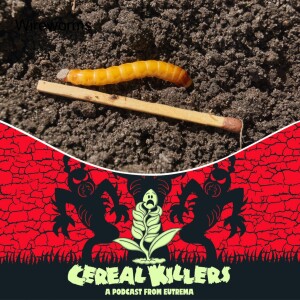
Tuesday Aug 06, 2024
Tuesday Aug 06, 2024
We discuss the intriguing and troublesome life cycle of wireworms, from their beginnings as eggs to their transformation into click beetles.
Discover why wireworms pose such a significant threat to crops like beetroot, cereals, and oilseed rape, and learn about their unique defense mechanism—a clicking noise designed to startle predators. The conversation also touches on effective control methods, including crop rotation, soil management, and the role of natural predators.
Additionally, the hosts explore the fascinating relationship between beetles and magnolia trees, and share insights on other insects with long life cycles, such as cicadas. Join us for an engaging discussion on managing wireworms and protecting your crops from these pernicious pests.
For more info, check out our blog: https://eutrema.co.uk/controlling-wireworms/
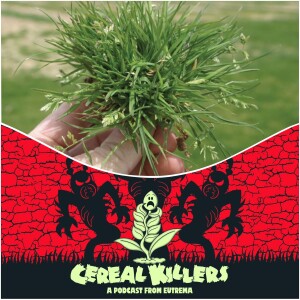
Tuesday Aug 13, 2024
Tuesday Aug 13, 2024
Meadow grasses, specifically Poa annua (annual meadow grass) and Poa trivialis (rough meadow grass).
Whilst these weeds may not pose a significant threat to crop yields, they present unique biological traits and can become pesky nuisances in certain conditions. Discover the fascinating details about Poa annua, its misleading name, and how it thrives in various environments, including its impact in New Zealand.
Learn about the ephemeral nature of Poa annua, its ability to propagate through both seeds and rhizomes, and its role as a host for the harmful ergot fungus. The discussion also covers Poa trivialis, its perennial nature, and its adaptability to compacted, damp soils, especially in no-till farming systems.
Join us as we explore these meadow grasses' resilience, their potential herbicide resistance, and the implications for farmers. Stay tuned for our next episode on the intriguing topic of chocolate spot. Thank you for listening!
https://eutrema.co.uk/shop/
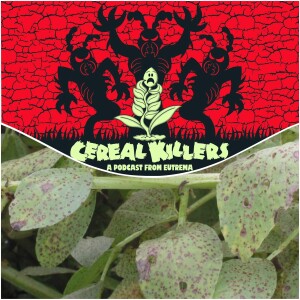
Wednesday Aug 21, 2024
Wednesday Aug 21, 2024
In this episode we chat about chocolate spot—a serious fungal disease affecting field and broad beans.
While the name might sound delicious, chocolate spot is anything but tasty. The discussion covers the causes, symptoms, and impacts of this disease, as well as effective methods for control. Learn about the differences between Botrytis fabiae and Botrytis cinerea, and why crop rotation and debris management are crucial.
With a touch of humor and some interesting historical tidbits, this episode is both informative and entertaining. Discover why fava beans are gaining popularity and the UK government's push for pea and bean research. Plus, get tips on using fungicides and other treatments to keep your crops healthy.
Don't miss out on this comprehensive guide to managing chocolate spot in your bean crops. Tune in now and join the conversation!
https://eutrema.co.uk/
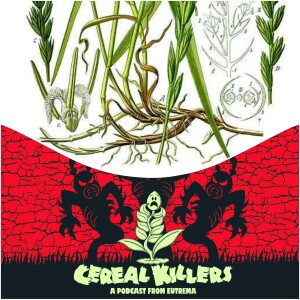
Thursday Aug 29, 2024
Thursday Aug 29, 2024
In this episode, Josie and Russ tackle the troublesome weeds; couch grass and onion couch grass.
Also known as twitch grass or quack grass, couch grass has a multitude of common names. Its scientific name, Elymus repens, hints at its creeping nature. This weed is a significant issue in horticulture and gardens, and it can be particularly tricky to control once its roots get intertwined with your plants.
We discuss the weed's reproduction via rhizomes and seeds, its impact on crop yield, and effective control methods such as cultivation and glyphosate application. They also touch on its role as an alternative host for pests and fungi.
Additionally, we explore onion grass, which is unrelated to couch grass but often confused with it. This variant of false oat grass also poses its own challenges and requires different control methods.
Tune in to learn more about these persistent weeds, their effects on your crops, and how to manage them effectively. Plus, get a glimpse into the hosts' favourite pasta dishes and their thoughts on chocolate pizza!
https://eutrema.co.uk/
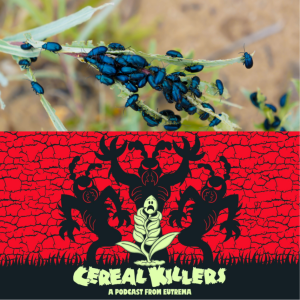
Thursday Sep 05, 2024
Thursday Sep 05, 2024
In this episode, Josie and Russell dive deep into the world of the small but mighty flea beetle, a pest with over 100 species that wreaks havoc on crops like oilseed rape and brassicas.
Learn about the life cycle of these beetles, their impressive jumping abilities, and the significant impact they have on crop yields. Discover the challenges of controlling flea beetles, from insecticides to innovative methods like companion planting and trap crops. Josie also shares fascinating insights on how scientists are studying flea beetles to inspire advancements in robotics and engineering.
Don't miss this engaging and informative episode, filled with interesting facts, practical advice, and a few light-hearted moments. Whether you're a farmer, gardener, or just curious about these tiny pests, there's something here for everyone.
Hit the bell icon to stay updated with our latest episodes and join the conversation by sharing your thoughts on who would win in the insect Olympics!
https://eutrema.co.uk/
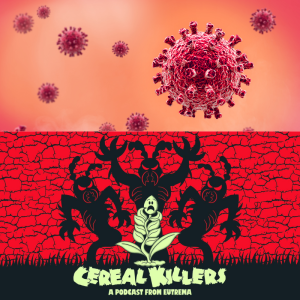
Friday Oct 18, 2024
Friday Oct 18, 2024
In this episode of Cereal Killers we focus on the notorious Barley Yellow Dwarf Virus (BYDV). As farmers brace themselves for the upcoming season, we explore the impact of this virus on winter wheat and barley, where it can lead to staggering yield losses of up to 60% and 50% respectively.
Join us as Russell discusses the intricacies of controlling BYDV, including the role of aphids as vectors, and the importance of timely aphid control measures. We cover a variety of strategies, from insecticide applications to innovative farming practices like direct drilling and the use of BYDV-tolerant crop varieties. Additionally, we touch on the complexities of the virus's science and explore the promising developments in black grass pathogenic spore trials.
Whether you're a seasoned agronomist or a curious listener, this episode provides valuable insights into managing one of the most serious threats to cereal crops. Tune in and discover how you can stay ahead of the curve in combating BYDV.
eutrema.co.uk

Thursday Oct 31, 2024
Thursday Oct 31, 2024
Welcome to a special Halloween edition of Cereal Killers, the podcast dedicated to the pests and diseases affecting cereal crops. In this episode, we delve into the fascinating world of the ghost moth, scientifically known as Hepialis humuli.
Discover the intriguing history and biology of this moth, from its misleading scientific name to its unique mating dance known as "lekking." Learn about the ghost moth's lifecycle, its impact on various crops, and its fascinating relationship with bats.
Join us as we explore the ghost moth's ability to adapt and survive, despite its lack of traditional senses like hearing and taste. Uncover the reasons behind its peculiar strategies and how they help it thrive in the wild.
Don't miss out on this spooky and educational episode that offers a special Halloween treat for our listeners.
Happy Halloween!
Dr Russell Sharp
https://eutrema.co.uk/
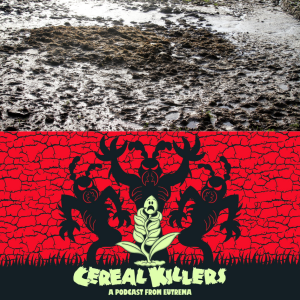
Monday Nov 11, 2024
Monday Nov 11, 2024
It was about time we recorded a podcast on flooding and waterlogging, seeing how 2024 has been a wash out of a year!
In this podcast we do a deep dive into all aspects of flooding; causes, effects on plants, positive effects, and how to solve issues around clay soils impeding drainage.
For more details on Eutrema's Liquid Gypsum please visit: https://eutrema.co.uk/shop/soil-conditioners/liquid-gypsum/
Dr Russell Sharp
Eutrema Ltd

Who are Eutrema?
- Founded in 2019 in Daventry, Northamptonshire.
- Primary manufacturer of all the products in our portfolio.
- We sell from factory gate to farm = no middlemen or distributors! Unique distribution model that minimises the costs to the farmers.
- Next-generation chemistry not found in any other supplier’s catalogues.
- Full technical support for customers on all aspects of crop health. We do not just advise on our own products.
- Clean room manufacturing facility. Open door policy for all customers to visit our Daventry site.
- For more details visit: https://eutrema.co.uk








